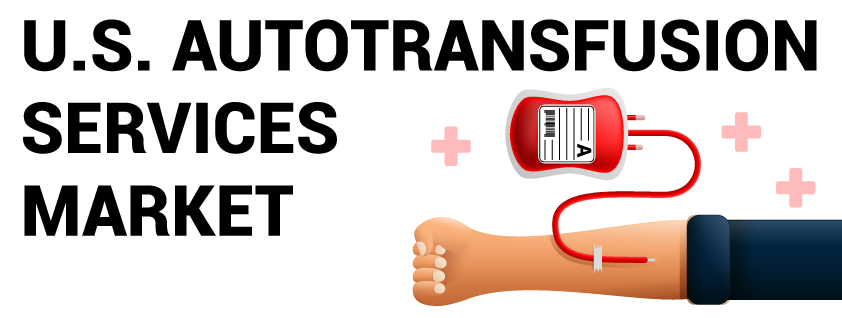U.S. Autotransfusion Services Market Size, Share & COVID-19 Impact Analysis, By Indication (Cardiovascular, Orthopedic, Neurology, Gynecology, Urology, Trauma, and Others), By End User (Hospitals, and Ambulatory Surgery Centers), and Forecast, 2020-2027
KEY MARKET INSIGHTS
 Listen to Audio Version
Listen to Audio Version
The U.S. autotransfusion services market size was USD 838.4 million in 2019 and is projected to reach USD 1,072.1 million by 2027, exhibiting a CAGR of 6.5% during the forecast period.
Autotransfusion, also known as cell-salvage, is a technique where a patient receives his own blood during a surgical procedure. According to an article published by the PLOS Journal, in 2019, an estimated 500,000 coronary artery bypass grafting (CABG) procedures were performed in the U.S. These surgeries, along with knee and hip replacement surgeries are usually associated with blood loss. Transfusion of blood is traditionally performed by using allogeneic blood, collected from another person, and transfused during a surgical procedure when required.
According to an article published by SpecialityCare, around 14.6 million units of blood are transfused annually in the U.S., at a cost of around USD 7.6 billion. However, the overall cost of allogeneic blood is higher, as compared to the cell-salvage technique, owing to various cost components. These include the cost of acquisition, pre-transfusion testing, storage, and transport costs, along with indirect costs associated with complications and increased hospital stay.
This has led to healthcare facilities focusing more on reducing the overall costs associated with blood transfusion, which has further paved the way for autotransfusion procedures. A specialized equipment or autotransfusion device, trained professionals, and qualified staff are some of the pre-requisites of autotransfusion.
Declining Number of Surgical Procedures amid COVID-19 Pandemic to Hamper Growth
The outbreak of the COVID-19 pandemic has had a negative impact on the U.S. autotransfusion services market. The number of autotransfusion procedures performed each year in the U.S. is directly proportional to the number of patients undergoing surgical procedures each year. During the pandemic, social distancing norms laid down by the government, along with various other regulations being imposed, has led to a decline in the number of patients undergoing surgical procedures. This is set to result in an overall decline in the demand for autotransfusion services in the country during the forthcoming period.
According to the Minneapolis Heart Institute Foundation, there was an estimated 40% drop in ST-elevation myocardial infarction (STEMI) procedures performed in the U.S. during Q1 2020. According to a study conducted using data from the American Joint Replacement Registry, an estimated 30,000 primary and 3,000 revision hip surgeries were estimated to be postponed each week during March and April 2020 in the U.S.
The outbreak has additionally led hospitals to postpone organ transplant procedures. Apart from that, around 50% to 55% of all other non-urgent elective transplants have been postponed. This has led to a significant decline in the demand for autotransfusion services in the U.S.
LATEST TRENDS
Request a Free sample to learn more about this report.
Gradual Shift towards Autologous Blood Transfusion is a Current Trend
The rising number of surgical procedures is set to subsequently propel the need for blood transfusion. Various risk factors, complications, and ethical issues related to allogeneic blood transfusion are leading to a gradual shift towards autologous blood transfusion. The latter is a safe alternative to allogeneic transfusion owing to its several advantages for rare blood groups and patients with ethical issues.
According to an article published by Annals of Surgery, in the U.S., out of the 145 patients undergoing aortic surgery, 56.0% of patients underwent autologous transfusion and rest under allogeneic transfusion. This marks the shift of patients towards autologous transfusions, creating a high demand for autotransfusion services in the U.S.
Also, according to various studies, there has been a 12.2% decline in allogeneic transfusion in the past 2-3 years in the U.S. The growing preference for autologous blood transfusions in the U.S. is set to create a higher demand for autotransfusion services in the country during the forecast period.
DRIVING FACTORS
Increasing Number of Surgical Procedures to Propel Growth
According to the American Academy of Orthopedic Surgeons (AAOS) and the Agency for Healthcare Research and Quality (AHRQ), an estimated 790,000 knee replacement and estimated 450,000 hip replacement procedures are performed in the U.S. each year. Various benefits of autologous blood transfusion over allogeneic transfusions, such as the reduced risk of infections, better oxygen transfer, enhanced activities of coagulation factors, and elimination of pre-transfusion inspections associated with allogeneic blood are expected to boost the demand for autotransfusion services in the U.S.
Also, the low cost of autologous transfusion, as compared to allogeneic transfusion, is propelling the adoption of cell-salvage procedures among healthcare providers in hospitals and other healthcare settings. This, combined with the entry of regional and domestic players in the U.S., offering an array of autotransfusion services for various indications to healthcare facilities, is fuelling the demand for these services in the market. This increasing demand for autotransfusion procedures is further augmented by the introduction of new autotransfusion devices being introduced by leading market players LivaNova PLC., Medtronic, and others.
RESTRAINING FACTORS
Risks Associated with Autotransfusion to Hinder Market Growth
According to an article published by Hokkaido University Hospital, the most frequent side effect of autotransfusion is a vasovagal reflex. It is a spontaneous reaction from the patient’s body during blood collection. The minor symptoms include dizziness, cold sweat, and a slight pressure drop. If the symptoms progress, it will cause nausea, vomiting, and a moderately severe drop in blood pressure.
Despite several advantages of autologous transfusion over allogeneic ones, there are certain risks associated with autotransfusion such as the depletion of plasma and platelets, side effects at the time of blood collection, disseminated intravascular coagulation, and renal insufficiency. These are limiting the adoption of autotransfusion services in the U.S. and making the concept of bloodless surgeries popular in the country.
SEGMENTATION
By Indication Analysis
To know how our report can help streamline your business, Speak to Analyst
Cardiovascular Segment to Dominate Stoked by Rising Number of These Surgeries
Based on indication, the U.S. autotransfusion services market is segmented into cardiovascular, neurology, orthopedic, gynecology, urology, trauma, and others. The cardiovascular segment dominated the U.S. market in 2019. Coronary artery bypass graft (CABG) and transcatheter aortic valve replacement (TAVR) are the major cardiac surgeries associated with blood loss during the procedure. The advantages of autologous blood transfusion during these procedures, along with the growing preference for autotransfusion services among healthcare providers in the U.S., are set to result in a higher share of the cardiovascular segment.
However, the orthopedic segment is projected to register a comparatively higher CAGR, owing to the growing number of knee and hip replacement procedures, as well as similar other orthopedic surgeries in the U.S. Besides, the presence of a large number of players offering autotransfusion services in the country.
The limited penetration of autotransfusion services in neurology and urology, coupled with the lower preference for autologous transfusion among healthcare providers for these procedures, has been pivotal in the lower share of these segments in 2019.
By End User Analysis
Hospitals Held a Dominant Share in 2019 Backed by Presence of Expert Staff
Based on end-users, the U.S. autotransfusion services market is segmented into hospitals and ambulatory surgery centers (ASCs). Autotransfusion procedures are characterized by the presence of expensive cell-salvage equipment, qualified autotransfusionist, and expert staff. Despite the growth of the number of surgeries being performed in ambulatory surgery centers in the U.S., CABG, and TAVR are still preferred in hospital inpatient settings. This factor is set to contribute to the growth of the hospitals segment. Also, the rising adoption of these services in hospital settings, as well as the rising presence of qualified staff & autotransfusionist on-board, would contribute to the high share of the segment in the U.S.
The ambulatory surgery centers segment is projected to register a comparatively higher CAGR during 2020-2027, owing to the rising number of orthopedic procedures being performed in these settings in the U.S. According to HCUP, an estimated 57% of the primary knee, 40% of hip replacement, and around 60% of spinal fusion procedures will be performed in ASCs by 2027 in the U.S.
KEY INDUSTRY PLAYERS
Extensive Service Portfolio & Widespread Geographical Presence to Help SpecialtyCare Maintain its Dominance
The U.S. autotransfusion services market is characterized by the presence of a large number of small and domestic players, with very few of them having a wide geographical presence in the country. One such player is SpecialtyCare, who is among the dominant companies in terms of perfusion services and one of the leaders in autotransfusion services. According to the company, it has assisted an estimated 350 hospitals in the U.S., by performing around 134,000 perfusion procedures in these settings in 2018.
The other key players include comprehensive care services and keystone perfusion. A strong and growing presence of these players across the U.S., along with the rapid expansion of services portfolio, will strengthen their market positions.
LIST OF KEY MARKET PLAYERS PROFILED IN THIS REPORT:
- Comprehensive Care Services (Michigan, U.S.)
- SpecialtyCare (Tennessee, U.S.)
- Keystone Perfusion (Pennsylvania, U.S.)
- Atlanta Surgical Services Inc. (Atlanta, U.S.)
- Vivacity Perfusion (Tennessee, U.S.)
- Carolina Autotransfusion, Inc. (South Carolina, U.S.)
- CENTRAL VALLEY PERFUSION, INC. (California, U.S.)
KEY INDUSTRY DEVELOPMENTS:
- January 2020 – SpecialityCare acquired Phoenix-based Perfusion services provider, Phoenix Perfusion Services, LLC (PPS), and Arizona Perfusion Supply Company, LLC (APS).
REPORT COVERAGE
An Infographic Representation of U.S. Autotransfusion Services Market
To get information on various segments, share your queries with us
The U.S. autotransfusion services market research report provides a detailed analysis of the market and focuses on key aspects such as leading companies, services, and leading indications. Besides this, the report offers insights into the market trends and highlights key industry developments. In addition to the aforementioned factors, it encompasses several factors that have created numerous growth opportunities and contributed to the advancement of the market over recent years.
Report Scope & Segmentation
ATTRI(BUTE | DETAILS |
Study Period | 2016-2027 |
Base Year | 2019 |
Forecast Period | 2020-2027 |
Historical Period | 2016-2018 |
Unit | Value (USD million) |
Segmentation | Indication and End User |
By Indication
|
|
By End User
|
|

Frequently Asked Questions
Fortune Business Insights says that the U.S. market size was USD 838.4 million in 2019 and is projected to reach USD 1,072.1 million by 2027.
Registering a CAGR of 6.5%, the market will exhibit steady growth in the forecast period (2020-2027).
The cardiovascular segment is expected to be the leading segment in this market during the forecast period.
The increasing number of surgical procedures is one of the major factors driving the growth of the market.
Comprehensive Care Services, Keystone Perfusion, Inc., and SpecialtyCare are the major players in the market.
The entry of domestic players with diverse service offerings is expected to drive the adoption of autotransfusion services in the U.S.
Get in Touch with Our Experts Speak to an Expert
-
Get in Touch with Us
-
US +1 833 909 2966 ( Toll Free )
-

 View Full Infographic
View Full Infographic






